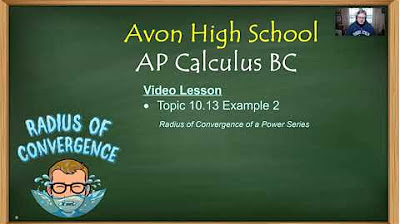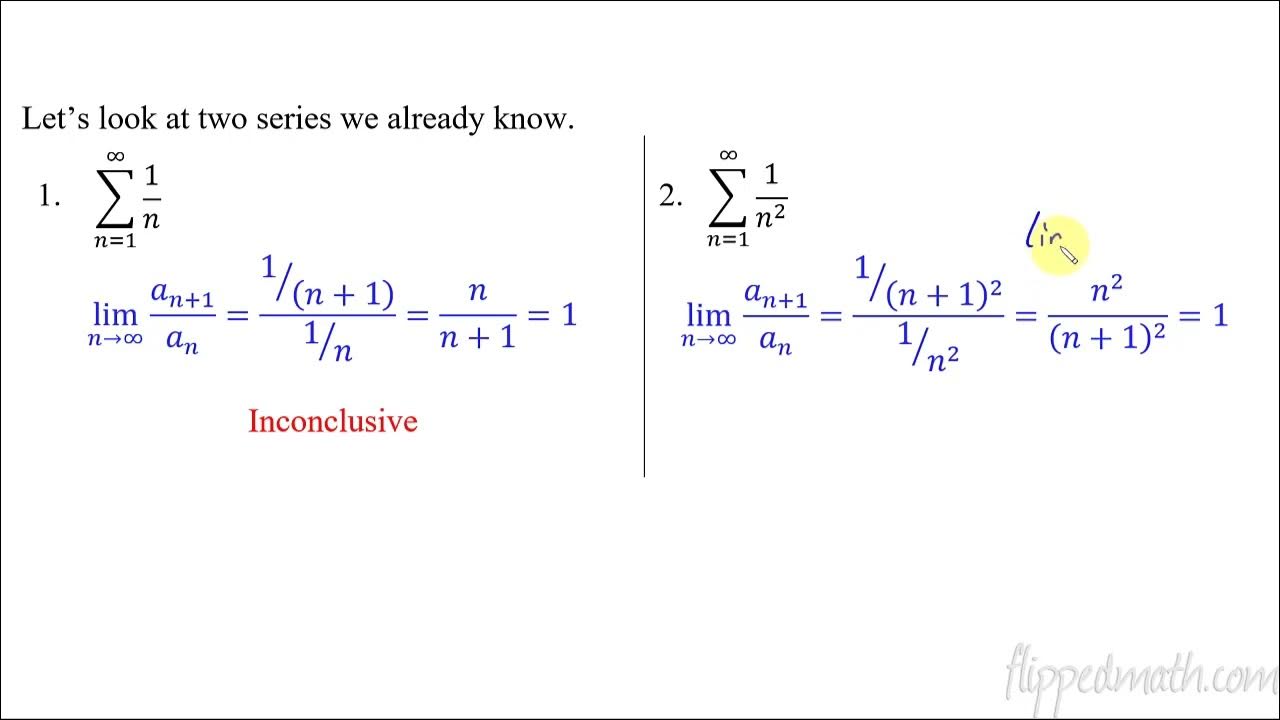Calculus BC – 10.13 Radius and Interval of Convergence of Power Series
TLDRIn this calculus lesson, Mr. Bean explores the concept of radius and interval of convergence for power series. He explains the difference between the two and how they are related, emphasizing the importance of identifying the center of convergence. The video demonstrates how to determine the interval of convergence using the ratio test and the three possible scenarios for convergence: to an interval, to all real numbers, or only to the center. Mr. Bean provides step-by-step examples, highlighting the need to check endpoints for inclusion in the interval of convergence and to simplify the ratio test expressions to find the radius.
Takeaways
- 📚 The lesson focuses on understanding the radius and interval of convergence for power series in calculus.
- 🔍 The radius of convergence is the distance from the center of a power series to the edge of its interval of convergence.
- 📐 The interval of convergence can be an open interval, a closed interval, or just a single point, depending on the series' behavior at the endpoints.
- 📈 The ratio test is used to determine the interval of convergence by comparing the limit of the ratio of consecutive terms as n approaches infinity.
- 🔑 If the limit of the ratio test is less than one, the series converges to an interval.
- ∞ If the limit equals zero, the series converges for all values of x.
- 🔄 If the limit equals infinity, the series converges only at the center point, x equals c.
- 📝 It's crucial to check the endpoints of the interval to determine if they are included in the interval of convergence.
- ✏️ Simplifying the ratio test expression is a key step in applying the test to find the interval of convergence.
- 📉 The series may diverge at the endpoints, which affects the determination of the interval of convergence.
- 📌 The radius of convergence is determined by the interval's endpoints, and if the series converges only at the center, the radius is zero.
Q & A
What are the two main concepts discussed in the calculus lesson?
-The two main concepts discussed in the calculus lesson are the radius and interval of convergence for power series.
What is the significance of the center in the context of power series?
-The center is significant because it is always part of the domain of convergence for a power series. It is the point around which the series is centered and is always included in the interval of convergence.
How does the power series differ in the provided examples?
-The power series in the examples differ by the presence of the term 'x - C'. The series is centered around 'x = C', and the absence of 'x - C' in some series indicates that they are centered around 'x = 0'.
What are the three ways a power series may converge?
-A power series may converge in three ways: 1) to an interval, 2) to all real numbers, or 3) only to the center (x = C).
What is the radius of convergence and how is it determined?
-The radius of convergence is the distance from the center of the power series to the edge of the interval of convergence. It is determined once the interval of convergence is found by measuring the distance from the center to the nearest endpoint of the interval.
What is the role of the ratio test in determining the interval of convergence?
-The ratio test is used to determine the interval of convergence by comparing the ratio of consecutive terms of the series as n approaches infinity. The limit of this ratio helps identify whether the series converges to an interval, all real numbers, or only to the center.
What happens if the limit of the ratio test equals zero?
-If the limit of the ratio test equals zero, the series converges for all values of x, essentially covering the entire real number line from negative infinity to infinity.
What is the significance of checking the endpoints of the interval of convergence?
-Checking the endpoints is crucial to determine whether the endpoints are included in the interval of convergence. This helps in accurately defining the domain where the power series converges.
How does the simplification process affect the determination of the interval of convergence?
-Simplification of the ratio test expression is essential to accurately determine the behavior of the series as n approaches infinity. This simplification helps in identifying the correct scenario (less than one, equals zero, or equals infinity) that dictates the interval of convergence.
What is the implication of the limit of the ratio test approaching infinity?
-If the limit of the ratio test approaches infinity, the series converges only to the center (x = C), indicating a very limited domain of convergence.
Why is it important to practice simplifying the ratio test expressions?
-Practicing simplification of the ratio test expressions is important because it helps in accurately determining the interval of convergence and the radius of convergence, which are fundamental in understanding the behavior of power series.
Outlines
📚 Introduction to Radius and Interval of Convergence
In this lesson, Mr. Bean introduces the concepts of radius and interval of convergence for Power Series. He explains that these concepts are related but distinct, with the interval of convergence being a set of values where the series converges. The radius is the distance from the center of the series (often x=0) to the edge of the interval. Mr. Bean emphasizes the importance of identifying the center of the series as it is always part of the domain of convergence. He outlines three scenarios for convergence: to an interval, to all real numbers, or only to the center. The lesson also covers the use of the ratio test to determine the interval of convergence, with different outcomes based on whether the limit of the ratio test is less than one, equals zero, or equals infinity.
🔍 Applying the Ratio Test to Find Convergence
This section delves into the practical application of the ratio test to determine the interval of convergence for a given power series. The process involves simplifying the ratio of the (n+1)th term to the nth term and analyzing the limit as n approaches infinity. Depending on whether this limit is less than one, equals zero, or equals infinity, the series converges to an interval, all real numbers, or only to the center, respectively. Mr. Bean demonstrates this process with an example, showing how to simplify the expression and solve the resulting inequality to find the interval of convergence. He also stresses the importance of checking the endpoints to determine if they are included in the interval of convergence.
📉 Checking Endpoints for Inclusion in the Interval of Convergence
Continuing the practical application, Mr. Bean explains the necessity of checking the endpoints of the interval obtained from the ratio test. This step confirms whether the series converges at the endpoints or if it only converges within the interval. The explanation includes a detailed example where the series is evaluated at specific x-values to determine divergence or convergence. The process involves substituting the endpoints into the series and observing the behavior. If the series diverges at an endpoint, that endpoint is not included in the interval of convergence. This step is crucial for accurately determining the interval and the radius of convergence.
📈 Simplifying Complex Ratio Test Expressions
In this part, Mr. Bean addresses the challenge of simplifying more complex expressions in the ratio test. He provides a step-by-step walkthrough of simplifying a given power series term, emphasizing the importance of careful cancellation and factorization. After simplification, the focus shifts to determining the limit as n approaches infinity and solving the resulting inequality to find the interval of convergence. The example demonstrates how to handle a series with factorial terms and powers of x, leading to the identification of the series' convergence properties.
🌐 Special Cases of Convergence: Center Only and All Real Numbers
The final part of the script covers special cases in the convergence of power series. Mr. Bean explains what happens when the limit of the ratio test equals infinity, indicating that the series converges only at the center, with the radius being zero. Conversely, if the limit equals zero, the series converges for all values of x, implying an infinite radius of convergence. These scenarios are distinct from the typical interval convergence and require a different approach in analysis. The lesson concludes with a reminder of the importance of practice in mastering the application of the ratio test and simplifying complex expressions.
Mindmap
Keywords
💡Power Series
💡Radius of Convergence
💡Interval of Convergence
💡Ratio Test
💡Center of the Power Series
💡Domain
💡Convergence
💡Divergent Series
💡Simplification
💡Endpoints
Highlights
Introduction to the concept of radius and interval of convergence for Power Series.
Explanation that radius and interval of convergence are related but distinct concepts.
Description of how the interval of convergence leads to the determination of the radius.
Illustration of Power Series with terms starting at n=0 and the role of the center (x=c).
Discussion on the three ways a Power Series may converge: to an interval, to all real numbers, or only to the center.
Introduction of the ratio test for determining the interval of convergence.
Clarification that if the ratio test limit is less than one, the series converges to an interval.
Explanation that if the ratio test limit equals zero, the series converges for all values of x.
Clarification that if the ratio test limit equals infinity, the series converges only to the center.
Demonstration of how to apply the ratio test to a specific Power Series example.
Emphasis on the importance of checking endpoints to determine if they are included in the interval of convergence.
Example of calculating the interval of convergence and radius for a Power Series centered at x=5.
Explanation of how the radius is determined as the distance from the center to the edge of the interval.
Demonstration of checking endpoint convergence for a series centered at x=2.
Example of a Power Series where the limit of the ratio test equals one, indicating convergence to an interval.
Clarification that if the limit equals zero, the radius is infinite, indicating convergence for all x.
Final example demonstrating the simplification process and application of the ratio test.
Transcripts
5.0 / 5 (0 votes)
Thanks for rating:





